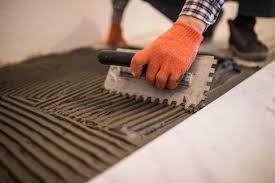Tile installation is essential to many home improvement projects, whether you’re renovating a bathroom, updating a kitchen backsplash, or adding a stylish floor to your living area. One of the critical components of successful tile installation is using the right tile adhesive. This guide will provide you with everything you need to know about tile adhesive, from the types available and their applications to step-by-step instructions on using them effectively. By the end of this guide, you’ll be equipped with the knowledge to fix your tiles with confidence.
Understanding Tile Adhesive
What is Tile Adhesive?
Tile adhesive, also known as tile glue or thin-set mortar, is a material used to bond tiles to a substrate, ensuring they stay in place and form a solid, durable surface. It is a crucial element in tile installation, affecting the longevity and appearance of the tiled surface.
Types of Tile Adhesive
Several tile adhesives are available, each suited to different types of tiles and substrates. Understanding these types will help you choose the right one for your project.
1. Cement-Based Adhesives
Cement-based adhesives are the most common type used for various tile installations. They come in powder form and must be mixed with water before application.
-
Standard Thin-Set Mortar: Suitable for most ceramic and porcelain tiles on walls and floors.
-
Modified Thin-Set Mortar: This mortar contains polymers that enhance adhesion, flexibility, and water resistance. It is ideal for areas exposed to moisture, such as bathrooms and kitchens.
2. Ready-Mixed Adhesives
Ready-mixed adhesives are pre-mixed and ready to use straight from the container. They are convenient and save time, making them popular for small projects and DIY enthusiasts.
-
Acrylic Adhesives: Best for smaller tiles and wall applications. Not recommended for large tiles or floors.
-
Epoxy Adhesives: Highly durable and resistant to chemicals, moisture, and temperature changes. Suitable for heavy-duty applications, such as commercial kitchens and industrial areas.
3. Specialized Adhesives
Specialized adhesives are designed for specific tile types or conditions.
-
Mastic Adhesives: These ready-to-use adhesives are suitable for dry areas and smaller ceramic tiles. They offer excellent adhesion but are not recommended for areas with high moisture.
-
Latex-Modified Adhesives: Enhanced with latex additives for increased flexibility and strength. Ideal for substrates that may experience movement or vibration.
Choosing the Right Tile Adhesive
Selecting the appropriate tile adhesive depends on various factors, including the type of tile, the substrate, the location of the installation, and the conditions the tiled area will be exposed to.
-
Tile Type: Porcelain, ceramic, natural stone, glass, and mosaic tiles may require different adhesives.
-
Substrate: The surface on which the tiles will be installed, such as concrete, drywall, plywood, or existing tiles.
-
Location: Indoor or outdoor installation, wet or dry areas.
-
Conditions: Temperature fluctuations, exposure to moisture, and foot traffic.
Preparing for Tile Installation
Tools and Materials Needed
Before you start, gather all the necessary tools and materials to ensure a smooth installation process.
-
Tile Adhesive: Choose the appropriate type based on your project requirements.
-
Tiles: Ensure you have enough tiles to cover the area, including a few extras for cuts and replacements.
-
Notched Trowel: For spreading adhesive evenly.
-
Mixing Bucket and Drill Mixer: If using powdered adhesive.
-
Tile Spacers: To maintain consistent gaps between tiles.
-
Level: To ensure tiles are laid evenly.
-
Tile Cutter or Wet Saw: Cutting tiles to fit edges and corners.
-
Rubber Mallet: Tap tiles into place without damaging them.
-
Sponge and Water Bucket: This is used to clean excess adhesive.
-
Grout and Grout Float: This is used to fill gaps between tiles.
-
Sealer: If required for the type of tiles you are using.
Surface Preparation
Proper surface preparation is crucial for a successful tile installation. The substrate must be clean, dry, and level.
-
Cleaning: Remove any dirt, dust, grease, or old adhesive from the surface. Use a vacuum or brush to ensure it’s spotless.
-
Leveling: Use a level to check for uneven areas. If necessary, use a leveling compound to create a smooth, even surface.
-
Priming: Applying a primer can improve adhesion on some substrates. Follow the manufacturer’s instructions regarding primer use.
Step-by-Step Guide to Using Tile Adhesive
Mixing the Adhesive
If you are using powdered tile adhesive, follow these steps to mix it correctly:
-
Measure the Water: Refer to the adhesive manufacturer’s instructions for the correct water-to-powder ratio. Pour the measured water into a mixing bucket.
-
Add the Powder: Gradually add the adhesive powder to the water while stirring continuously with a drill mixer.
-
Mix Thoroughly: Continue mixing until you achieve a smooth, lump-free consistency. Let the mixture sit for a few minutes, then remix before use.
Applying the Adhesive
-
Spread the Adhesive: Using a notched trowel, spread the adhesive onto the substrate. Hold the trowel at a 45-degree angle to create even grooves.
-
Apply Enough Adhesive: Ensure enough adhesive to cover the substrate without leaving gaps. The notched trowel size depends on the tile size and type.
-
Comb the Adhesive: Use the notched side of the trowel to comb the adhesive, creating parallel ridges. This ensures proper coverage and bonding.
Laying the Tiles
-
Press the Tiles: Press each tile firmly into the adhesive, twisting slightly to ensure full contact. Use tile spacers to maintain consistent gaps between tiles.
-
Check for Level: Use a level to check that each tile is even with its neighbors. Adjust as necessary by adding or removing adhesive.
-
Tap into Place: Use a rubber mallet to gently tap tiles into place, ensuring they are securely embedded in the adhesive.
Cutting Tiles
-
Measure and Mark: Measure the area where the tile needs to be cut and mark the cutting line on the tile.
-
Cut the Tile: Use a tile cutter for straight cuts or a wet saw for intricate cuts and harder materials.
-
Smooth Edges: After cutting, smooth the edges with a tile file or sandpaper to avoid sharp edges.
Cleaning and Curing
-
Clean Excess Adhesive: Immediately clean any adhesive by squeezing between tiles with a damp sponge.
-
Allow to Cure: Follow the manufacturer’s instructions for curing time. Avoid walking on or disturbing the tiles during this period.
Grouting and Finishing
Choosing the Right Grout
Grout fills the gaps between tiles and helps secure them in place. There are different types of grout:
-
Sanded Grout: Contains sand particles and is suitable for wider gaps (over 1/8 inch).
-
Unsanded Grout: Smooth and ideal for narrower gaps (under 1/8 inch).
-
Epoxy Grout: Highly durable and resistant to stains and moisture. Best for high-traffic and wet areas.
Applying Grout
-
Mix the Grout: If using powdered grout, mix it with water according to the manufacturer’s instructions until you achieve a smooth consistency.
-
Spread the Grout: Using a grout float, spread the grout over the tiles, pressing it into the gaps. Work in small sections to prevent the grout from drying out.
-
Clean Excess Grout: After the grout has been set for a few minutes, clean excess grout from the tile surfaces with a damp sponge. Rinse the sponge frequently to avoid spreading grout haze.
Sealing the Grout
Sealing the grout can protect it from stains and moisture. After the grout has fully cured, apply a grout sealer according to the manufacturer’s instructions. This step is especially important in areas exposed to water, such as bathrooms and kitchens.
Tips for Successful Tile Adhesive Application
Follow Manufacturer Instructions
Always follow the adhesive and grout manufacturers’ instructions regarding mixing ratios, application methods, and curing times. This ensures the best results and prevents issues related to improper use.
Work in Small Sections
Work in manageable sections to prevent the adhesive from drying out before you lay the tiles. This also allows you to make adjustments and ensure even spacing.
Maintain Consistent Gaps
Use tile spacers to maintain consistent gaps between tiles. This not only ensures a professional look but also makes grouting easier.
Check for Level Frequently
Check for level regularly during the installation process to avoid uneven tiles. This is especially important for large tiles and floor installations.
Clean as You Go
Clean excess adhesive and grout immediately to prevent them from hardening on the tile surface. This makes finishing the installation easier and ensures a clean, professional look.
Common Mistakes to Avoid
Using the Wrong Adhesive
Choosing the wrong adhesive for your tile type or substrate can result in poor adhesion and potential tile failure. Always select the appropriate adhesive based on your specific project requirements.
Inadequate Surface Preparation
Failing to properly clean and level the substrate can prevent tiles from adhering correctly. Prepare the surface thoroughly before applying adhesive.
Over or Under Mixing Adhesive
Incorrectly mixed adhesive can affect its performance. To achieve consistency, follow the manufacturer’s instructions for mixing ratios and techniques.
Not Allowing Adequate Curing Time
Rushing the curing process can compromise the strength of the adhesive bond. Allow the recommended curing time before grouting or using the tiled area.
Neglecting Grout Sealing
Skipping the grout sealing step can lead to stains and moisture damage, especially in wet areas. Always seal the grout as recommended for added protection.
Advanced Techniques and Tips
Large Format Tiles
For large-format tiles (tiles larger than 15 inches on one side), use a large-format tile adhesive and a larger notched trowel to ensure adequate coverage. Back-buttering (applying adhesive to the back of the tile) may also be necessary to achieve proper adhesion.
Installing Tiles Over Existing Tiles
If installing new tiles over existing tiles, ensure the existing tiles are clean, level, and securely bonded. Use a specialized adhesive designed for tile-over-tile applications to provide a strong bond.
Using a Tile Leveling System
A tile leveling system can help prevent lippage (uneven tiles) and ensure a flat, even surface. These systems use spacers and clips to hold tiles in place while the adhesive cures, producing a professional finish.
Applying Adhesive to Vertical Surfaces
When applying adhesive to vertical surfaces, such as walls, use a non-sagging adhesive to prevent tiles from slipping. Start from the bottom and work your way up, using tile spacers to maintain even gaps.
Conclusion
Using tile adhesive correctly is crucial for achieving a durable and aesthetically pleasing tiled surface. You can confidently fix your tiles by understanding the different types of adhesives, preparing your surface properly, and following step-by-step installation guidelines. Remember to choose the right adhesive for your project, work methodically, and avoid common mistakes to ensure a successful tile installation. With this ultimate guide, you are now equipped with the knowledge and skills to tackle your next tiling project and achieve professional results confidently.
Looking for a tile fixing adhesive? Contact us today to buy wall tile adhesive.



